Small
Munsterlander
WHAT YOU get when you join the Prairie Peak Family
We will help create a great fit and facilitate a harmonious relationship between your Small Munsterlander and your family. We pledge to give you high quality service from initial talks through training and throughout your dog’s life. We will always be there for both of you. Day or night. Forever.
Litter Update
Step 1: Application for Small Munsterlander
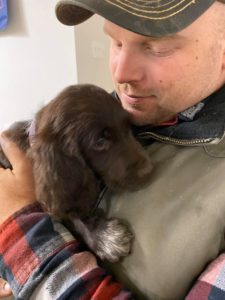

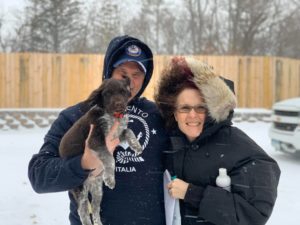
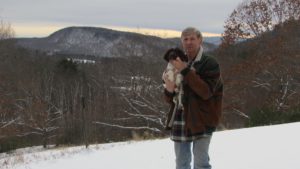
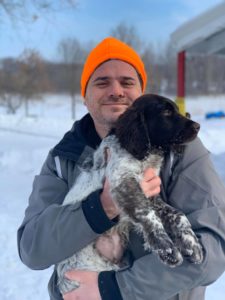
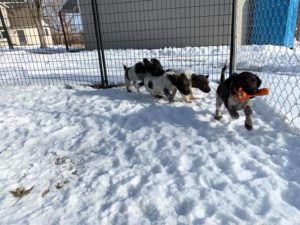
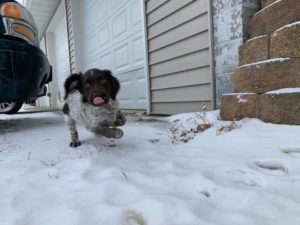
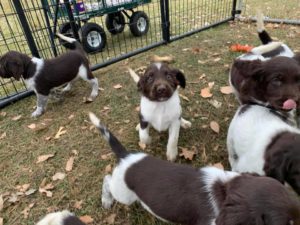
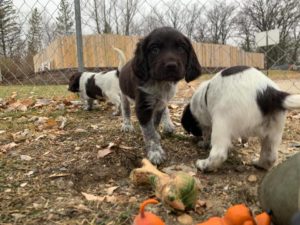
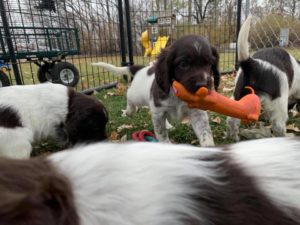
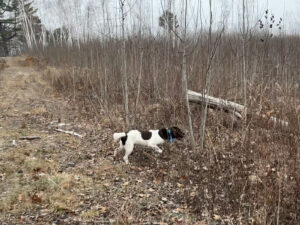
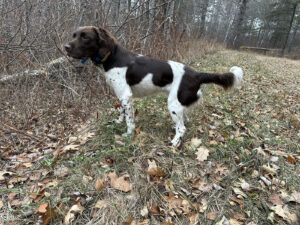
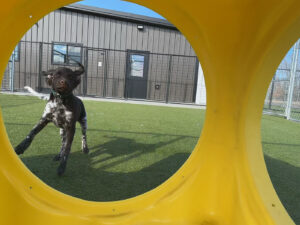
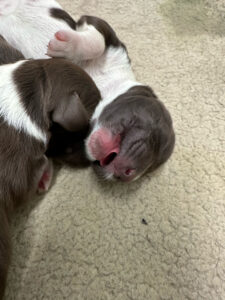
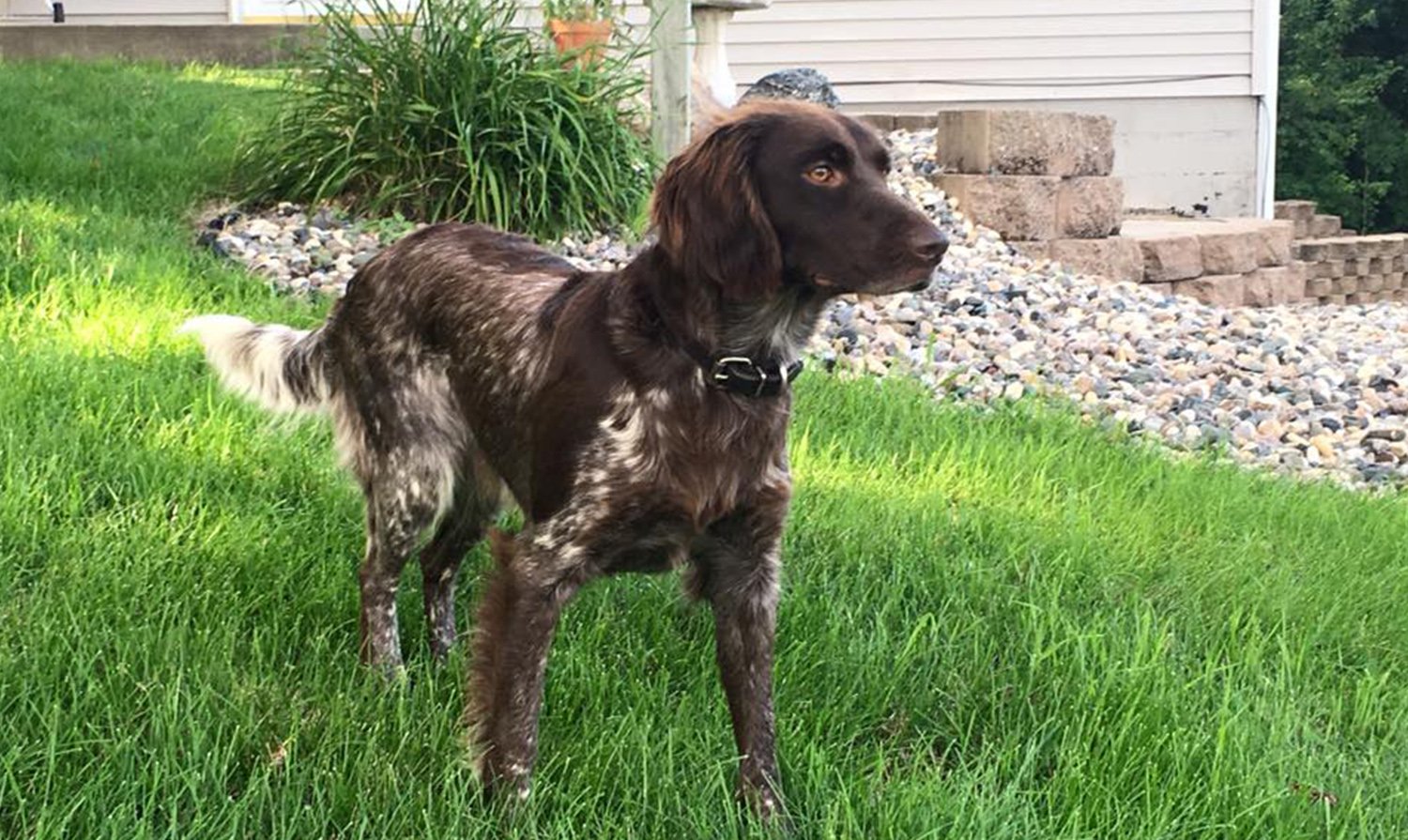
One of the four original versatile hunting breeds, the Small Munsterlander is a wonderful all-around gun dog and household companion. The Munster (pronunciation: ‘mün-st r)(loosely: ‘moon-stur) can efficiently carry out the duties of a pointer and retriever of both fur and feathered game from land or water.
With an increase in the number of hunters and hunting enthusiasts, and the systematic cultivation of game stock resulting from a change in the German hunting laws during the middle of the 19th century, the breeding of new German pointing dogs began. There are reports saying that around 1870 long-coated Wachtelhunds (German Spaniels) were well known in the Munsterland region. These dogs were firm in pointing; had enormous scenting abilities; and were also able to retrieve. In 1906, the well-known poet, Hermann Löns, made a public appeal in the magazine Unser Wachtelhund to give him a report on the still existing specimens of the red Hanovarian Heath Hound. As a result, he and his brothers discovered a pointing Wachtelhund they called Heidewachtel.
The Löns brothers and other well-known dog breeders, like the Baron of Bevervörde-Lohburg, put efforts into getting Heidewachtel breeding stock into other regions in Germany as well. Mr. Heitmann, a teacher from Burgsteinfurt, achieved first success with his line breeding. Several other lines, known as the so-called ‘Dorsten type’, appeared during the following years in Westphalia. On March 17, 1912, the Verband für Kleine Münsterländer Vorstehhunde (Club for Small Munsterlander Pointing Dogs) was finally founded. At that time, the Club expressed its aims as follows: “The Club pursues the purpose to promote the purity and the true breeding of the long-coated small pointing dog that has been bred in the Munsterland for many decades.” A lack of fixed breed characteristics at that time inhibited breeding activities as well as Club activities. Starting in 1921, breeders finally began to follow the breed standard drawn up by Mr. Friedrich Jungklaus.
Nevertheless, the true origin of the Small Munsterlander Pointing Dogs has not been proven.
In addition to being a tireless hunter and tracker, the Munster was developed to double as the family pet and watchdog. The Munsters of today do far more than just hunt. Because of their superior scenting and tracking abilities, Munsters are being used for Search and Rescue (finding lost people). And, because of their high intelligence, cooperative nature, and calm demeanor, Munsters are being used as Service (Assistance) Dogs.
The Munster is an amazing dog, both in the home and in the field. The Munster is a versatile breed – a pointing dog who will hunt and retrieve both furred and feathered game on land or in water. They are known for their exceptional tracking ability. Most Munsters retrieve game naturally and love the water. Females of this breed average 35-50 pounds and males average 45-60 pounds. We try to produce dogs at the middle-lower end of the FCI Standard, so our females typically weigh 35-40 pounds and our males typically weigh 45-50 pounds. Munsters have a soft, dense, medium length coat with feathering on the ears and legs and a well-flagged tail. They minimally require 20-30 minutes of off-lead exercise four times per week. Ideally they should get off-lead exercise daily.
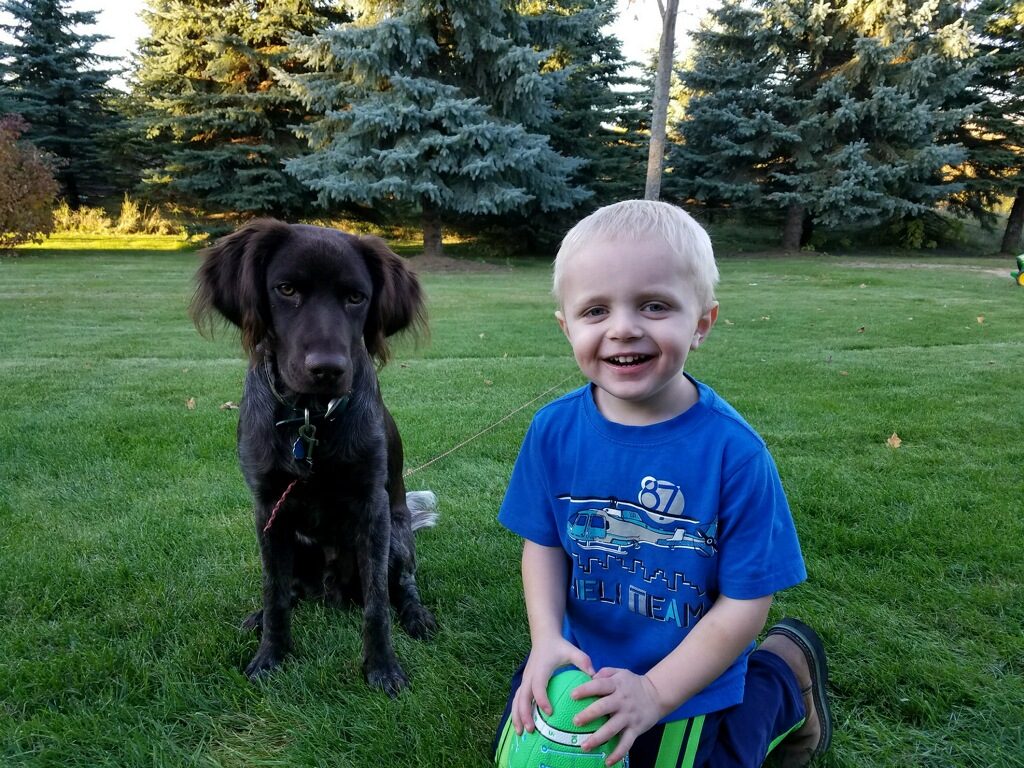
Preferred Homes
We prefer to place our puppies in hunting homes and will only consider a non-hunting home if the puppy will regularly participate in activities that utilize his/her natural talents, such as hunt testing (e.g. NAVHDA, VHDF, UKC, AKC), tracking, retrieving, or search and rescue. Although Munsters are probably the best house dogs of all the versatile breeds, they were bred to work and need a “job” for good health and happiness. Most importantly, Munsters require regular, off-lead exercise. If you cannot take your Munster somewhere to run off-lead for at least 20 minutes, 4 days per week (approximately every other day) – at a minimum, this is not the breed for you.
We also prefer our puppies to go to homes where they will spend daily, quality time with their owners. Munsters require a lot of human interaction and will become depressed if regularly left alone for long periods of time. If your Munster will be left alone for several hours a day, such as while you are at work, we would like you to utilize an outdoor kennel for her.
Even if your Munster will be in the house with another dog, spending 8-12 hours per day, 5 days a week inside does not provide enough mental and sensual stimulation for an intelligent hunting dog. Outside, your dog will be able to see and smell the many things going on around him and you will come home to a much calmer and happier dog.
Male/Females Differences

We charge the same price for either sex, as they are equally good hunters and family companions. It is absolutely untrue that females are better hunters, are easier to train, or are better with children. Actually, Munster males tend to do better with young children and are often easier to train than are females. Males are easy-going, openly affectionate, patient, wanting to please, sensitive, and loyal. Since they are a little bigger than females, they tend to handle a youngster’s rough housing in stride. Therefore, if you have young chilren, we recommend you select a male puppy. Munster males have a temperament similar to Lab and Golden Retriever females. Female Munsters are also very affectionate and love people of all ages, but they tend to be more aloof and more difficult to train due to stubbornness.
If you have other dogs who will be sharing your home with your new Munster, you should give serious consideration to which sex is likely to get along the best with your current canine family member(s). If you have a neutered male, regardless of breed or size, it makes no difference what sex your new puppy is. They will get along fine. If you have an intact male, he will get along equally well with a neutered male or spayed female Munster. Two intact males can get along fine sharing a home/kennel, unless/until an intact female comes along. Then they may fight. It generally is best if the intact males are not close in age. An intact male and an intact female will, of course, get along well. However, the intact male may experience medical problems if not bred.
Therefore, if you do not plan to frequently breed your male, you should have him neutered if he will be in constant contact with an intact female. Even spayed females can be very dominant. If you already have a dominant female ‘ruling the roost’ at home, she will get along best with a male (intact or neutered). Two females (spayed or intact) can get along fine sharing a home/kennel, but you need to prepare yourself for the possibility that one of them may some day challenge for dominance.
Choosing Your Puppy
 No matter how much we’d like there to be some scientific method of choosing the best puppy from a litter, there really isn’t one. What constitutes the “best” puppy is extremely subjective and what becomes of a puppy is very much in the hands of its owner. So long as you are buying a properly socialized, healthy puppy from a sound breeding by a reputable breeder, it won’t matter which puppy you choose. You could close your eyes, reach in and take home whichever puppy you happened to grab and you’d have the raw material for a great hunting and family companion.
No matter how much we’d like there to be some scientific method of choosing the best puppy from a litter, there really isn’t one. What constitutes the “best” puppy is extremely subjective and what becomes of a puppy is very much in the hands of its owner. So long as you are buying a properly socialized, healthy puppy from a sound breeding by a reputable breeder, it won’t matter which puppy you choose. You could close your eyes, reach in and take home whichever puppy you happened to grab and you’d have the raw material for a great hunting and family companion.
It is possible to predict a bit about a puppy’s future personality based on the puppy’s size relative to his siblings. The biggest puppy will most likely be laid back and easy-going. This is because he never had to scrap with his siblings for anything. He will normally be very patient with young children. You should take the introduction of new things, such as gunfire, slowly and carefully when training this puppy. This puppy will also need frequent off-lead outings in order to build the boldness needed to become an excellent hunter.
If you do not have the time to take your puppy on frequent off-lead adventures, do not choose the biggest puppy in the litter. On the flip-side, the smallest puppy will most likely be outgoing, fearless and energetic. This is because she always had to scrap with her siblings for everything. You should be firm, consistent and patient when training this puppy, as it may be difficult to hold her attention.
Because we are human and are programmed to prefer things we find attractive, you should pick a puppy you like the looks of. If you really like how your dog looks, it will make your bond much stronger than if you dislike or are indifferent to how he looks. If you think your dog is gorgeous, you will be proud to show him off. You might even overlook some of his bad behaviors. If you think your dog is ugly, he will never become your “once in a lifetime” dog, no matter how intelligent, talented and well-behaved he is. This is not to say you should choose your favorite-colored puppy from a breeder and/or litter that is other than your first choice. Choose your breeder, then your pairing from that breeder and then choose your puppy. All Small Munsterlander puppies are born brown/white. The roan coloring develops over time, but it is possible to tell if a puppy will be brown/white or roan shortly after birth.
Testing your puppy
Naming Your Puppy
If you are ever unable to care for your Small Munsterlander we can help. As breeders and professional trainers, not only do we understand dog behavior, but we have the resources to place your dog into the right home. We will adopt your Small Munsterlander without hesitation or judgement and go to work finding the right home for him. We have a long list right now of people actually wanting a mature dog.
The Rehoming Process:
1) Educate us about your dogs life, age, health condition, and so on.
2) Arrange the pickup/drop off details and then surrender your dog over to us.
3) Evaluate, vet, and train the pup as needed for the next home.
4) Contact people on our list until we find the right match.
5) Arrange a visitation play day with potential owners.
6) Facilitate adoption day and provide 24/7 care and support during the transition.
7) Follow up with new owner and remind new owner we are always here for them. For life.
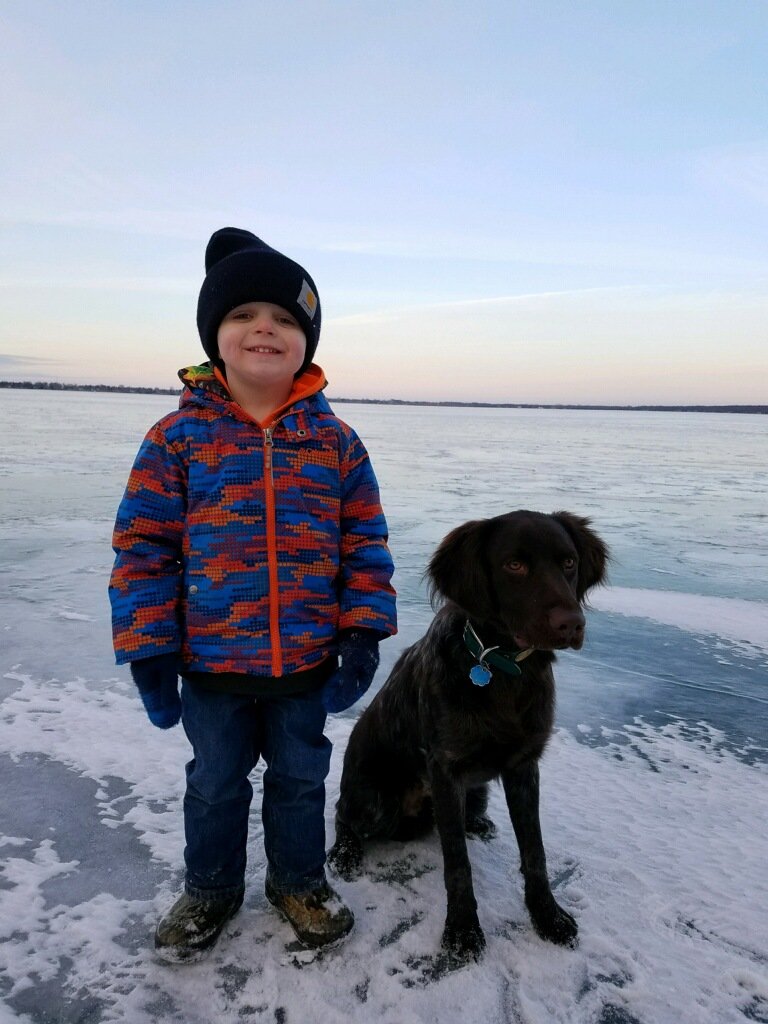
The Puppy Adoption Process:
- Learn about this amazing breed! We encourage you to learn as much about the breed as you can by thoroughly reading the content on our website, looking through our Facebook photo albums, visiting us for a hands on tour, and external sources such as NAVHDA and the Small Munsterlander club of North America.
- Fill out our adoption application form and then text us to set up a time for a phone call to talk details.
- Place a $500 deposit via check, venmo, or credit card to reserve yourself a puppy from our kennel.
- Recieve a call from us when the next litter is born to discuss if the timing is right for you.
- If you designate your desire to receive a pup from the current litter, you will be marked as “reserved” for this litter.
- Then before pups are 2 weeks old you will receive an email with an attached Small Munsterlander informational litter packet. Here is what will be covered in this email:
- Litter Announcement – When the puppies were whelped
- Adoption and visitation dates – List of adopting families in order of pick – What to expect on adoption day
- Brief recap of our contract – Book recommendations – Day in the life of a puppy at PPK
- A little about Prairie Peak Kennels: Who we are, what we do, and why we do it – Our mission statement
- Why we choose Life’s Abundance – How to order Life’s Abundance – Puppy feeding schedule – About our Health Guarantee
- What we recommend for puppy accessories/equipment and why
- Important puppy developmental and training milestones – How to get started on the right foot with training
- When to spay/ neuter and why – Other puppy health and wellness information
- Individual final details – Schedule or confirm puppy pick up/ shipping date
- Adoption day! We will go over your paperwork, recap on potty training, crate training, and feeding tips!
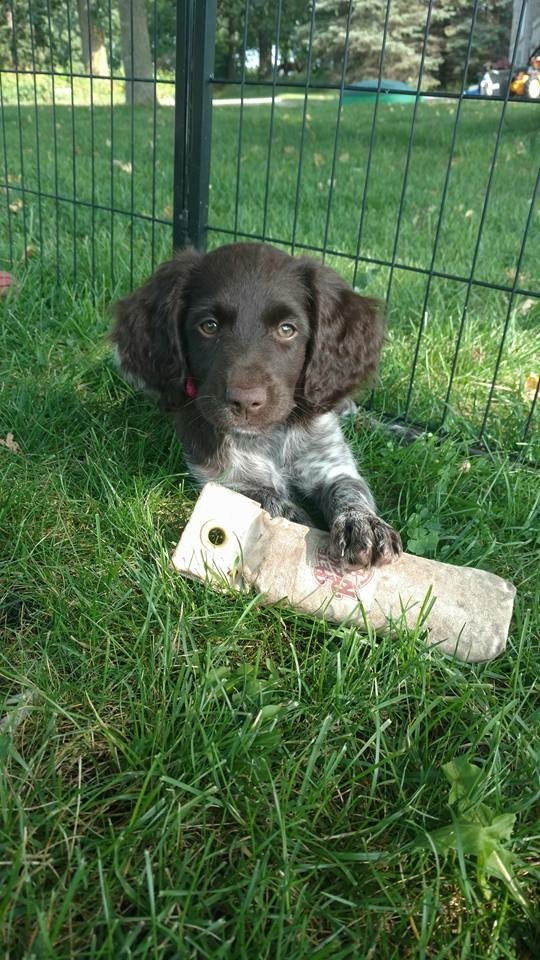
1) Training – We know your dog as we helped raise him/her! We understand their development and temperament because we know your pup’s parents and understand the breed. We would be honored to help you with training.
2) Boarding – Dogs that are here for boarding get tons of exercise and socialization which is great for development. Plus, what a great reunion for pup and mother!
3) In-Ground Fence installation – We can help you keep your dog safe by installing an in-ground fence in your yard. It’s a cost effective way to keep them safe but still allows them the freedom to be active.
We will work together with you to ensure that your pup lives the healthiest life possible from start to finish. If you continue feeding the food we have given to your pup, we truly believe your pup’s health will never be an issue. We have tried, tested, and proven Life’s Abundance to be of the highest quality and standards. Should your pup develop any major genetic or nutritional health issues while feeding Life’s Abundance and their products, we will provide you a free replacement puppy.
10 Year Guarantee Terms
Because Prairie Peak believes so strongly that nutrition plays a big part in the health of an animal, Prairie Peak is offering an optional “10 Year Free Replacement Puppy Guarantee”. This guarantee stipulates that the puppy will be solely fed “Life’s Abundance” dog food, treats, and supplements. The reason Prairie Peak has chosen to offer this guarantee is because so many dogs and cats are acquiring serious life threatening health risks through poor diet and vitamin deficiency.
In regards to genetic defects, there are never any guarantees that the puppy would be free of a genetic disorder from past generations. Since Prairie Peak may not know if there are any potential weaknesses in the puppy, poor diet and lack of vitamins can worsen these conditions if found.
Should a Prairie Peak puppy, while on Life’s Abundance, develop a genetic or nutritional ailment within the first 10 years of its life, Prairie Peak will offer a replacement puppy. The Adopting Family must immediately notify Prairie Peak upon first knowledge of this disease and a written diagnosis showing cause of death/disability from a licensed veterinarian must be provided. This guarantee pertains to genetic and nutritional issues only and does not include other ailments such as, but not limited to, neglect, abuse, or any injuries the puppy may have sustained, including accidental death. There is no cash value to this agreement and the original puppy must be returned to Prairie Peak Kennels within seven days of diagnosis. Any other fees or money vested in the rearing of the puppy, such as, but not limited to transportation, vet bills, training, or other fees is not included. There is no cash value to this guarantee.
Prairie Peak believes that Life’s Abundance Pet Food and their products is the best way to provide the pup with optimal health so that the pup can live a long and happy life! (for more info click our nutrition tab)
Small Munsterlander Puppy (8-10 weeks) | $1,850
6 Month Old Started Dog | $5,100
Deposit to Hold a Puppy | $500
The contract is also listed on the adoption application form for your review and signature.
Terms for Adoption
1) The Adopting Family agrees to provide the Puppy with a life-long commitment, comfortable and safe living environment, prompt medical attention, proper grooming, and responsible care. This includes keeping the Puppy parasite free, up-to-date with vaccinations, and proper nutrition and hydration. The Adopting Family promises never to allow the Puppy to roam freely without proper fencing or supervision. Prairie Peak has micro-chipped the Puppy in order to facilitate the Puppy’s return if lost or stolen, which Adopting Family agrees to register. The Adopting Family promises to give the Puppy adequate off-lead exercise for his/her optimal health and happiness. If the Puppy will not be hunted on a regular basis, the Buyer agrees to have the puppy regularly participate in activities that utilize his/her natural talents and abilities, such as hunt testing (e.g. NAVHDA, VHDF, UKC, etc), tracking, or search and rescue.
2) Prairie Peak guarantees the Puppy to be of sound health at the time of adoption. The Puppy’s health record has been given to the Adopting Family. The Adopting Family agrees to take the Puppy to a licensed veterinarian of their choice within 3 days for a physical examination. At or before the examination on the 3rd day, should the Puppy be determined to be in ill health, the Adopting Family may provide Prairie Peak with a copy of the veterinarian’s invoice for services rendered and the Prairie Peak will reimburse the Adopting Family (up to $200) for the cost of medications and/or procedures recommended by said veterinarian to return the Puppy to sound health
3) The Adopting Family agrees not to spay/neuter the Puppy until his/her growth plates have closed, generally between the age of 14 and 16 months. If the Adopting Family desires to spay/neuter the Puppy prior to age 14 months, the Family must provide Prairie Peak with a written statement from a licensed veterinarian stating that he/she has examined the Puppy and all the Puppy’s growth plates have closed. A breach of this provision will automatically negate any health guarantee.
4) If at any time the Adopting Family can no longer provide care the Puppy, Prairie Peak is to be notified and given the first option of resuming full ownership of the puppy in order for Prairie Peak to locate the Puppy a new home. The Puppy will be returned to Prairie Peak at the Adopting Family’s expense with all registration papers and health/vaccination records. Prairie Peak reserves the right to approve/prohibit any transfer of the Puppy to a third party which includes giving the pup to other family members unless they have been approved. Prairie Peak must be involved in this transaction so we can help facilitate proper eduation and support to the new owner. Under no circumstances may Puppy be sold, transferred, leased, traded, or given away to a puppy mill, pet shop, research laboratory, animal shelter, humane society, or similar facility; nor can the Puppy be sold, transferred, leased, traded, or given away to anyone other than Prairie Peak Kennels without our written permission. We are a Small Munsterlander breeding and rescue and will do a great job finding your pup a new home if you should no langer be able to provide the care they need.
5) The Adopting Family agrees to contact Prairie Peak if any questions or concerns arise about the Puppy, such as housing, diet, personality traits, health, or training. The Adopting Family agrees to keep Prairie Peak informed of any health problems as they occur. This provides the Breeder with important information on the health of Prairie Peak puppies for future breeding decisions.
6) The Puppy can be registered by owner with NAVHDA (North American Versatile Hunting Dog Association) but not required.
7) Prairie Peak highly encourages the Adopting Family to run the Puppy in the NA (Natural Ability) test and will assist the Adopting Family in preparing the Puppy for his/her test.
8) If the Adopting Family intends to breed the Puppy, that decision needs to be made now before placing a deposit as there are many breeding requirements that need to be followed starting when the puppy is born. It is in the opinion of Prairie Peak that the Puppy’s physical structure is of breed quality. The Adopting Family understands and agrees that the Prairie Peak’s opinion is not a guarantee of breed quality physical structure, nor is it a guarantee that the Puppy will be approved for breeding. The Adopting Family agrees to follow all rules, requirements, guidelines, and procedures established by either the SMNCA or Prairie Peak (if the Adopting Family does not want to be a part of the SMNCA). In order to breed your Puppy, you must receive breeding approval by either SMNCA or Prairie Peak. This assures that the breed will continue to conform to the breed standards for generations to come. Your puppy also has a limited registration by default. Prairie Peak has limited the registration of your puppy to ensure no unplanned/unapproved breeding’s can be registered. In order to remove the registration on your puppy you must submit a breeding plan to Prairie Peak for approval and pay a one time cost to remove the limited registration. The cost is the current Prairie Peak cost of a puppy. Limited Registrations are usually removed after the Puppy is approved for breeding.
10 Year Guarantee Terms
Because Prairie Peak believes so strongly that nutrition plays a very big part in the health of an animal, Prairie Peak is offering a “10 Year Free Replacement Puppy Guarantee”. This guarantee stipulates that the puppy will be solely fed “Life’s Abundance” dog food, treats, and supplements.The reason Prairie Peak has chosen to offer this guarantee is because so many dogs and cats are acquiring serious life threatening health risks through poor diet and vitamin deficiency.Prairie Peak believes that Life’s Abundance products provide optimal nutritional benefits ensuring good health and longevity for the dog, which is why Prairie Peak is willing to stand behind this guarantee. If the puppy, that has been adopted from Prairie Peak, does not reach its life expectancy of at least 10 years, the Adopting Family will be eligible to get a free replacement puppy of equal value. In regards to genetic defects, there are never any guarantees that the puppy would be free of a genetic disorder from past generations. Since Prairie Peak may not know if there are any potential weaknesses in the puppy, poor diet and lack of vitamins can worsen these conditions if found.Therefore by providing the puppy with quality food and supplements, Prairie Peak is hoping to reduce the chance of these potential weaknesses from hindering their longevity and quality of life. This guarantee does not include transportation fees, vet bills, training, genetic issues not related to nutrition, or other fees and does not cover accidental death, feeding other brands of food/ treats/ supplements/ etc., neglect, abuse, or injuries that the puppy may sustain while being a part of your family. There is no cash value to this guarantee.Prairie Peak believes that Life’s Abundance Pet Food and products is the best way to provide the puppy with optimal health, so that the puppy can live a long and happy life! (for more info click our nutrition tab)
Pricing Terms
Prairie Peak’s Small Munsterlanders have an adoption fee of $1,850 plus tax. Flights/Shipping is an additional $400-450 if the puppy is shipped at 8-10 weeks, higher if puppy is older. The shipping includes airfare, crate, and health certificate. Shipping costs outside the United States and ground transportation delivery will be discussed upon the first deposit.
A $500 deposit is collected to guarantee you a puppy from Prairie Peak Kennels in the order by date the deposit was provided. Once you are on the list, we will explain to you the future litters we have planned and you will indicate which litter fits your schedule best. Once a deposit is made, it is non refundable. Once a decision is made on which litter you would like, the deposit is non transferable by your/the owner’s choice and you are locked into getting a puppy from that litter. If there are not enough puppies of the sex you desire from that litter, Prairie Peak will transfer you to the top of the list for the next scheduled litter. Prairie Peak has multiple litters each year. We do not guarantee any color prefrences which is why you should place your deposit with plenty of time so you can be higher up on the pick list. If you are unhappy with your colored pup, you may forfeit your deposit for the current litter and place another $500 deposit for a future litter. Your first deposit date will still govern and you would then be near the top of the pick list affording you the ability to choose a color more easily on the next litter.
These agreements will continue for the Puppy’s life and both the Adopting Family and Prairie Peak have the right to enforce these agreements. This document contains the entire agreement between the Adopting Family and Prairie Peak, and no statement, promises, or inducements made by either party that is not contained in this written agreement shall be valid or binding. This document will be construed and enforced under the laws of the State of Minnesota. By signing this form below both parties agree to all of the terms listed in this document.
“We just got our second munsterlander from Prairie Peak. Such a great family business. The quality of service, attention to our questions, and their knowledge about dogs and training is so valuable for me as I learn more about this amazing breed. I’ll always go back to Jack at Prairie Peak for all of my dogs needs!” ~Simon and Anna with their 2 Small Munsterlanders, Reggie & Chap.
